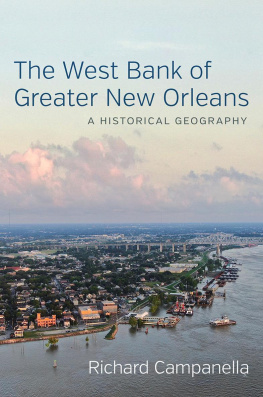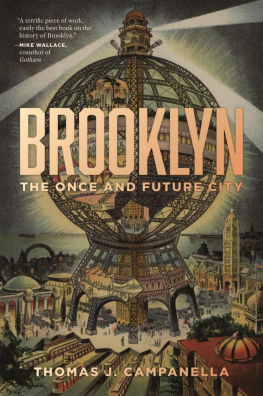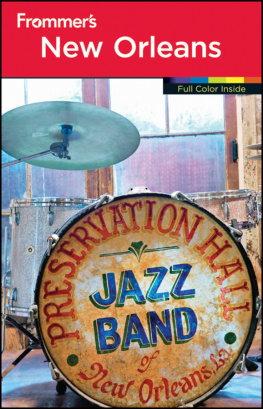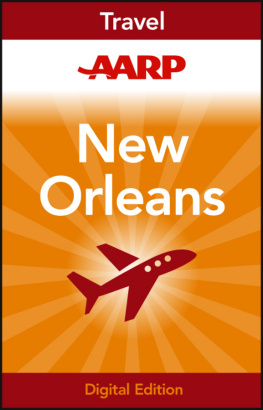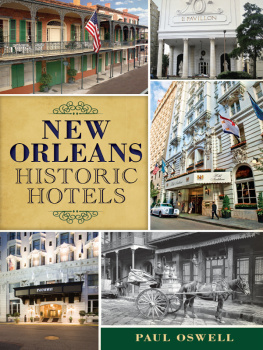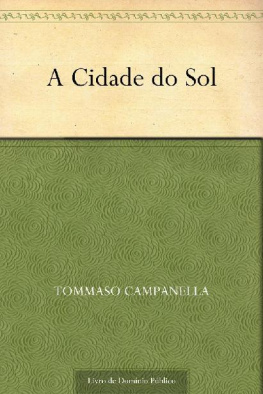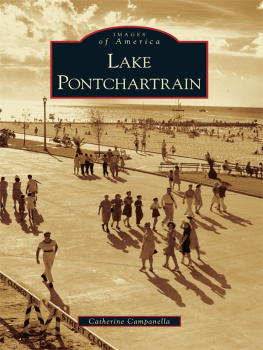CITYSCAPES OF NEW ORLEANS
CITYSCAPES OF
NEW ORLEANS
RICHARD CAMPANELLA
LOUISIANA STATE UNIVERSITY PRESS
BATON ROUGE
Published by Louisiana State University Press
Copyright 2017 by Louisiana State University Press
All rights reserved
Manufactured in the United States of America
First printing
DESIGNER: Michelle A. Neustrom
TYPEFACES: Whitman, text; Adagio, display
PRINTER AND BINDER: Sheridan Books, Inc.
LIBRARY OF CONGRESS CATALOGING-IN-PUBLICATION DATA
Names: Campanella, Richard, author.
Title: Cityscapes of New Orleans / Richard Campanella.
Description: Baton Rouge : Louisiana State University Press, [2017] | Includes bibliographical references.
Identifiers: LCCN 2017008826| ISBN 978-0-8071-6833-2 (cloth : alk. paper) | ISBN 978-0-8071-6834-9 (pdf) | ISBN 978-0-8071-6835-6 (epub)
Subjects: LCSH: New Orleans (La.)History. | New Orleans (La.) Description and travel. | NeighborhoodsLouisianaNew OrleansHistory. | ArchitectureLouisianaNew OrleansHistory. | New Orleans (La.) Geography.
Classification: LCC F379.N557 C239 2017 | DDC 976.3/35dc23
LC record available at https://lccn.loc.gov/2017008826
The paper in this book meets the guidelines for permanence and durability of the Committee on Production Guidelines for Book Longevity of the Council on Library Resources. 
For Marina and Jason
All human landscape has cultural meaning
no matter how ordinary....
All our cultural warts and blemishes are there,
and our glories too.
PEIRCE F. LEWIS, Axioms of the Landscape, 1976
CONTENTS
PREFACE
The cultural landscape, wrote geographer Carl O. Sauer in 1925, is fashioned out of a natural landscape by a cultural group. Culture is the agent, the natural area is the medium, the cultural landscape is the result. A cityscape, then, is the urban corollary of a cultural landscape, the tout ensemble of all that constitutes a city: its underlying natural landscape, its biota and water, its built environment fashioned by various human agents and their social settlement patterns, its infrastructure and idiosyncrasies. A cityscape is the unique visible signature of the multifarious expressions of urban geography.
As each generation inscribes its projects and priorities into urban space, it renders spatial circumstances to which succeeding generations may conformor transform. The results build up anew all around us, but rarely do they completely erase their antecedents. A trained eye can thus read a cityscape and, with the help of archival documents and other sources, extract from it stories about our past, which in turn help explain the present and guide the future.
Reading cityscapes lets you see a whole different world. It brings the past to life, and makes the banal extraordinary. An off-plumb driveway on Royal Streetwhat could be more mundane?suddenly couldnt be more interesting once you understand it traces precisely the geometry of an old French colonial fort. That confusingly juxtaposed street grid in the Seventh Ward becomes enchanting when you realize it reflects plantation lines surveyed in 1720. That long-ago deluge in 1849 might seem irrelevant until you understand policies enacted in its aftermath helped paved the way for the complete transformation of the deltaic plainand New Orleanss future flood risk.
Once you see these stories in the cityscape, you cant help but want to share them, and thats why I compiled this book. Cityscapes of New Orleans is a collection of analytical essays on the spatial dimensions of the Crescent City, a metropolis whose very sobriquet exudes geography. It has one primary goal, and that is spatial explanationelucidating the why behind the where. It explains the morphology of the metropolis, including street grids, parcel lines, and municipal systems; the character and distribution of its peoples, neighborhoods, cultures, and economies; the origins of its architecture and fate of its prominent buildings; the challenges of its urban environment and trauma of its disasters; and the complex relationship it maintains with the rest of the nation and world.
New Orleans has intrigued me since my early childhood (sight unseen, growing up in Brooklyn, New York), and has engrossed and perplexed me for the twenty-plus years Ive been studying it. That interest has produced nine prior books and hundreds of articles, some of which appear in this volume in the form of essays (sans the apparatus of footnotes and references, which may be found in my academic work). The essays, though grouped thematically, are self-standing and may be read in any sequence, as this book pretends to be neither a traditional chronology nor a comprehensive history of the city. Rather, it is a reader intended for those who know and love the city; a certain base knowledge of the metropolis is presumed but not crucial. The essays are adaptations of my contributions to three publications over the past six years, and are presented here with their permission: NOLA.com/ The Times-Picayune, where I have a monthly Cityscapes column; Preservation in Print, to which I contribute monthly articles; and Louisiana Cultural Vistas, the quarterly publication of the Louisiana Endowment of the Humanities, where I have a column named Geographers Space.
I am indebted to a number of individuals and institutions in the making of Cityscapes of New Orleans. First and foremost, I thank my wife Marina Campanella and son Jason Campanella for their love and support. I gratefully acknowledge the Tulane University School of Architecture and Dean Kenneth Schwartz for the academic position which enables me to conduct this research, and to the New Orleans Center for the Gulf South, directed by Rebecca Snedeker, where I am a Monroe Fellow.
Deep gratitude goes to Susan Langenhennig, editor of the InsideOut section of NOLA.com/The Times-Picayune, who cold-called me in 2013 with an invitation to be a contributing writer for New Orleanss oldest and largest newspaper. Susan and I agreed to name the column Cityscapes, which has since become a popular monthly feature, and is paired with a WWNO radio interview of me by journalist Eve Troeh. This volume would not have happened without Susan and her editing and production skills making Cityscapes possible. I also thank former editor-in-chief of NOLA.com/The Times-Picayune Jim Amoss for his support and permission to include the essays in this volume, and extend my appreciation to current editor and vice-president of content Mark Lorando and president of NOLA Media Group Tim Williamson as well.
Similarly, I am indebted to Danielle Del Sol and the late Mary Fitzpatrick of the Preservation Resource Center, editors of Preservation in Print, who extended a similar invitation to me in 2012, and to the staff of the Louisiana Endowment for the Humanities, including Brian Boyles and Miranda Restovic as well as former editors David Johnson and Michael Sartisky, for my Geographers Space column in Louisiana Cultural Vistas. I have been writing for all three periodicals ever since, and it has been a rewarding experience. Additional thanks go to editors Nancy Levinson of Places Journal, Errol Laborde of New Orleans Magazine, and Joel Kotkin of New Geography, all of whom have published articles of mine and granted permission for their inclusion in this volume.
I also wish to thank the staff at Louisiana State University Press, namely Director MaryKatherine Callaway, Executive Editor Rand Dotson, and Senior Editor Catherine L. Kadair, as well as freelance editor Stan Ivester.
And of course, I am most indebted to the city and people of New Orleans, who fashioned these splendid cityscapes and have kept me busy ever since.
Next page

